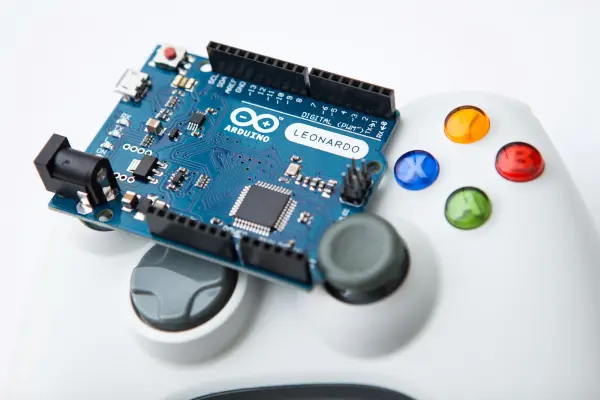Introduction
Creating your own game controller using an Arduino board can be an exciting and rewarding project for both beginners and experienced hobbyists. With the widespread popularity of gaming, custom controllers offer a unique and personalized gaming experience. This step-by-step guide will walk you through the process of making your very own Arduino game controller, allowing you to unleash your creativity and technical skills.
Whether you are a gaming enthusiast looking to enhance your gaming experience or a tech-savvy individual eager to delve into the world of Arduino, this project provides an excellent opportunity to learn about electronics, programming, and hardware integration. By following this guide, you will gain valuable insights into the principles of circuitry, coding, and interfacing electronic components, all while having fun and creating a functional device.
The Arduino platform, known for its user-friendly interface and extensive community support, serves as an ideal foundation for this project. By leveraging the versatility of Arduino, you can customize your game controller to suit your preferences, whether it’s for a specific game genre or a particular gaming console. Furthermore, the skills acquired during this project can be applied to various other DIY electronics endeavors, fostering a deeper understanding of hardware and software integration.
This guide aims to provide clear and concise instructions, making the process accessible to individuals with varying levels of technical expertise. Whether you are new to Arduino or have prior experience with microcontrollers, this project will enable you to gain practical skills and knowledge that can be applied to future electronic projects. Get ready to embark on an engaging journey of creativity, problem-solving, and technical exploration as we dive into the exciting world of Arduino game controller creation.
Materials Needed
Before diving into the creation of your Arduino game controller, it’s essential to gather the necessary materials and components. The following items will be required to complete this project:
- Arduino Board: The heart of the project, the Arduino board serves as the central processing unit for the game controller. Opt for a reliable and compatible Arduino board, such as the Arduino Uno or Arduino Mega.
- USB Cable: A standard USB cable will be needed to connect the Arduino board to your computer for programming and power.
- Joystick Module: This component allows for precise control in games and is essential for creating a functional game controller. Ensure that the joystick module is compatible with the Arduino platform.
- Pushbuttons: Select high-quality pushbuttons to serve as the action buttons on the game controller. The number of pushbuttons will depend on the desired layout and functionality of the controller.
- Resistors: Various resistors will be required to protect the components and ensure proper voltage levels within the circuit. Refer to the specifications of the components for the appropriate resistor values.
- Breadboard and Jumper Wires: A breadboard and jumper wires will facilitate the prototyping and connection of the components, allowing for a modular and adjustable setup during the construction phase.
- Soldering Iron and Solder: If permanent connections are preferred, a soldering iron and solder will be necessary for securing the components onto a perfboard or custom circuit board.
- Computer with Arduino IDE: A computer equipped with the Arduino Integrated Development Environment (IDE) is essential for programming and uploading code to the Arduino board.
- Game Controller Enclosure (Optional): If desired, an enclosure or housing for the game controller can be crafted using 3D printing, laser cutting, or traditional fabrication methods.
By ensuring that you have all the required materials at hand, you can proceed with confidence, knowing that you are well-equipped to embark on this exciting DIY electronics project.
Setting Up the Arduino
Before delving into the construction of the game controller, it is crucial to set up the Arduino board and ensure that it is ready for programming and hardware integration. Follow these steps to prepare the Arduino for the upcoming stages of the project:
- Install Arduino IDE: Begin by downloading and installing the Arduino IDE on your computer. The Arduino IDE is available for various operating systems and can be obtained from the official Arduino website. Once installed, launch the IDE to verify that it is functioning correctly.
- Connect the Arduino Board: Using a standard USB cable, connect the Arduino board to your computer. Ensure that the board is recognized by the computer and that the necessary drivers are installed. The Arduino IDE should detect the connected board, allowing you to proceed with programming.
- Install Board Drivers (If Necessary): In some cases, specific Arduino boards may require additional drivers to be installed on the computer. Refer to the documentation provided by the board’s manufacturer to determine if any additional drivers are needed and install them accordingly.
- Select the Correct Board and Port: Within the Arduino IDE, navigate to the “Tools” menu and select the appropriate Arduino board from the “Board” submenu. Additionally, choose the correct port to which the Arduino board is connected. This step is essential for ensuring that the code is uploaded to the correct board.
- Test the Connection: To verify that the Arduino board is properly set up and communicating with the computer, upload a simple test sketch, such as the “Blink” example, to the board. This will confirm that the board is functioning as expected and is ready for further programming.
By carefully following these steps, you can establish a solid foundation for the Arduino board, ensuring that it is primed for the subsequent stages of the project. With the board set up and the necessary software in place, you are now prepared to proceed with the hardware integration and programming required to create the Arduino game controller.
Source: How To Make An Arduino Game Controller

